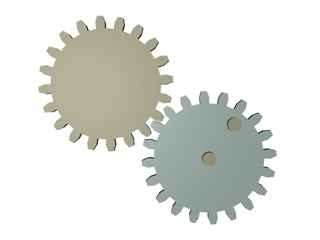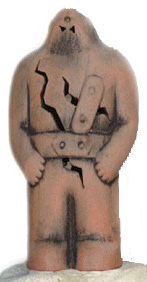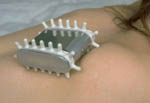Lectures 1&2
FIT4012: Artificial Life,
Procedural Modelling & Animation
General Course References
|
Watt, Watt,
"Advanced Animation and Rendering Techniques, Theory and Practice"
Chapters 15, 16, 18 ACM Press, Addison-Wesley, 1992
|
For more pointers and as an excellent reference
|
|
Levy, S.,
"Artificial Life - The Quest For A New Creation"
Jonathan Cape 1992
|
A readable introduction to artificial life
|
|
Langton, Christopher G. (ed),
"Artificial Life"
Santa Fe Institute Studies in the Science of Complexity, Vol VI, Addison-Wesley
1989
Varela, F.J., Bourgine P. (eds),
"Toward a Practice of Autonomous Systems"
Proc's of the First European Conference on Artificial Life, MIT Press
1992
|
Some pioneering conference proceedings in artificial
life
|
- Adaptive systems
- Animats
- Artificial Life
- Autonomy
|
Complex systems
Genetic Algorithm
Self-Organization
Synthetic Biology, etc. |
|
A sample set of google search terms to try |
Book reviews and a brief description of some of the above books are online.
|
|
Overview
This course is largely (but not exclusively) concerned with the modelling
of natural phenomena.
Here are some characteristics of animate objects which will be of interest in this
course...
- Morphology (shape / form)
endo/exo-skeleton, musculature, membrane
- Texture and surface characteristics
hair, fur, scales, feathers, flesh, bark, thorns, spines,
veins, spots etc.
- Nervous / sensory / perceptory systems
visual, aural, olfactory, touch
- Growth / development
plants, animals
- Locomotion
swim, walk, fly, roll, slither
- Interactions with animate and inanimate objects
flee, pursue, communicate, consume, envelop, push, collide,
mate, destroy
Here are some characteristics of in-animate objects which will be of
interest in this course...
- Shape
jagged, twisted, worn, rounded, rocky, amorphous, porous
- Texture and surface characteristics
translucent, glistening, misty, glowing, stained, veined
- Interactions with other objects
bounce, flex, break, adhere, stretch, cover, vibrate, absorb,
transmit, reflect, refract, sink, repel, crumble, shatter, fold, score
Why do natural phenomena in particular require special modelling techniques?
- Humans are very good at recognizing faulty attempts at visualizing the real world
Film industry demands realism
- Some degree of accuracy is required for scientific purposes
Analysis of: bush fire behaviour, weather patterns, hurricane
paths, tidal movement, success of pesticides, crop development in drought
or areas of high salinity
- Behaviour of 'simple' inanimate objects is in fact extremely complex
Dispersion of smoke in a breeze, crumpling of a piece of paper,
water dripping from a tap, coin descending through a fluid
- Animate objects are many orders of magnitude more complex than the most sophisticated
artificial and inanimate objects
Interaction of cells in a human body to produce 'conscious thought'
Special techniques for modelling natural phenomena may exploit the computer's
speed in order to handle complexity.
Manual modelling
Visual models of natural structures may be represented using any of the computer
graphics modelling techniques.
Models may be produced by hand by manipulating:
|
|
- graphics primitives
- splines... (the list goes on)
|
...via a GUI, keyboard and mouse, or from data obtained by measurement (using
scanners and range-finders etc.) from the real world.
|
|
Here are some tools for interactive modelling
using Specular Infini-D (mid 90's).
(3D modelling and animation software based on primitives)
- Translating, rotating, scaling a primitive
- Ray tracing the current view
- Creating a new primitive of a specific type
- Joining and breaking hierarchies of primitives
- Adding lights and cameras to a scene
- Moving and zooming the current camera view
|
|
|
...and some tools for interactive modelling using the old Hash
Inc. Animation Master.
(3D modelling and animation software based on splines) (mid 90's)
- Adding new splines
- Adding control points to existing splines
- Breaking splines
- Peaking / smoothing splines at control points
- Selecting control points to manipulate
- Scaling, rotating a spline
- Extruding a spline
- Produce a surface of revolution from a spline
- Apply texture / surface property to a patch
- Flip or view normals of a patch
- Create splines around text outlines
Interactive methods are tedious for the creation of complex structures.
Even current software offers little improvement compared to these 10+ year
old user interfaces.
Imagine trying to build a detailed model of a tree trunk
and branches by manually positioning and shaping thousands of differently
sized branch
segments...
and then having to add the leaves!
|
Manual animation
Manual computer animation is tedious when models are:
- complex and have many degrees of freedom
|
human figure
|
- required to interact with one another
|
tap-dancing human figure tossing a coin
|
- expected to move in accordance with the laws of physics
|
snow-boarding, tap-dancing human figure
rolling a coin down a ravine
|
|
|
snow-boarding, tap-dancing human figure
rolling a coin down a ravine into a pond and falling in after it
(Kids, don't try this trick at home
unless supervised by an adult.)
|
In all but the most trivial of cases, manual computer animation is a difficult,
time-consuming process.
Procedural modelling
- Model geometry and surface specified algorithmically or mathematically
- The inclusion of time-varying parameters facilitates procedural animation
|
|
void setGeometryAndColour (double time)
{
for (long i=-2; i<20; i++)
{
for (long j=-2; j<20; j++)
{
controlPt[i][j]-> x = i;
controlPt[i][j]-> y = sin(i*time);
controlPt[i][j]-> z = j;
cel[i][j]-> red = (1+ sin(i*time)) / 0.5;
cel[i][j]-> green = 0.0;
cel[i][j]-> blue = 0.0;
}
}
}
|
| Image from Macintosh Graphing Calculator |
Sample code to create a plane containing sin waves in
colour and geometry |
|
|
|
| Image
created using the interactive "Artmatic",
procedural texture generator by U&I Software |
Image showing structure of the function used to create
the Artmatic image (left) |
Procedural Animation
Computer code is used to determine / control how the model changes over time
(Just add a parameter 't' to your procedural models for a simple example of
this)
General methods include but are not limited to:
-
Script-based systems
Work with actors (objects in an animation) which
Special-purpose animation scripting languages have been developed which
offer high-level descriptions of what an actor is to do.
 |
E.g. Define a "car" actor
and four "wheel" actors.
Each frame, the car may be moved some distance. The car actor passes
the distance it moves on to the wheel actors, that respond to these
messages by rotating the correct amount so that they appear to have
rolled along a surface without slipping. |
-
Physically-based modelling
Specify a set of bodies and their physical properties
Specify the manner in which forces will be applied to bodies
Model some aspect of physics in order to simulate the behaviour of bodies
acting under forces as applied by/during:
 |
- collision detection and response
- fluid dynamics
- rigid and articulated body dynamics
- deformation
|
...and run the simulation for some time-span, rendering the objects at
regular intervals.
-
Behavioural animation
Specify a set of agents and their properties
- tendencies to mate,
- eat,
- sleep or
- change colour
- visual acuity... etc.
Specify a set of behavioural rules for each agent
eg. An agent simulation for an undergraduate student:
If (Need (food))
Move-Towards (Union Building)
Else If ((Weather == SUNNY) AND (Visible (mate))
{
Set-FacialExpression (cheerful)
Move-Towards (mate)
}
Else
Sleep(5)
and run the simulation for some time-span, rendering the objects at regular
intervals
Specify probabilities of certain events occurring
eg. tendencies for spontaneous combustion / emission of
particles or shoots of grass
Seed / constrain the simulation
eg. specify boundaries within which fireworks or plants
are to emerge
and run the simulation for some time-span, rendering the objects
at regular intervals
General principles of procedural modelling and animation
- None of the above methods are set in concrete
- All of the above techniques may be combined
- Improvise
Dorin's Razor
for procedural modelling
|
Decide on your purpose...
|
|
Science
Model exactly the aspects of the real system...
|
?
|
Art
Model (or ignore) any aspects of any system... |
|
...necessary to achieve the desired result
|
Failure to observe this simple rule is guaranteed to result in much wasted
effort and heartache.
An Introduction to Artificial Life
Some themes (not 'truths') of a-life:
- The study of "life as it could be"
- Life as a property of form, independent of matter
- Synthesis and bottom-up approaches
- Complex, global behaviour, emergent from simple, local rules
Some opinions (not 'truths') on a-life:
Langton et. al. 1991, Alife (USA) II...
"Artificial Life is a field of study devoted to understanding life by
attempting to abstract the fundamental dynamical principles underlying
biological phenomena, and recreating these dynamics in other media - such
as computers - making them accessible to new kinds of experimental manipulation
and testing"
A living system can be viewed as having an input (stimulus), an output
(response) and some internal control acting on the input to produce the
output.
Bourgine & Varela 1992, Alife (Europe) I...
"Artificial Life can be better defined as a research program concerned
with autonomous systems, their characterization and specific modes of
viability."
A living system can be viewed as an autonomous device with its autonomy
/ viability arising through internal self-organizing processes which are
responsible for its behaviour.
Historical "Artificial Life"
|
Hero of Alexandria's pneumatic animals
|
1st C. AD
|
 |
|
The Golem of Prague
|
~1400->
|
 |
|
Jacks, clockwork armoured figures
|
~1400->
|
 |
|
Vaucanson's duck
|
1735
|
 |
|
Mary Shelley's "Frankenstein"
|
1818
|
 |
|
Von Neumann's self-reproducing automata
|
1929->
|
 |
|
Penrose's machines
|
1959
|
 |
|
Conway's "Game of Life"
|
1970
|
 |
|
Braitenberg's vehicles
|
1984
|
 |
|
Dawkin's biomorphs
|
1986
|
 |
|
Reynold's boids
|
1987
|
 |
|
Marionettes, Automata etc.
|
~early ->
|
 |
Artificial Life Art |
recent |

|
Artificial Life Techniques
- Genetic Algorithms (with explicit,
implicit
or interactive fitness
functions)
- Physical simulations (with abstract
or real-world-modelled Physics and Chemistry)
- Multiple agent / ecosystem simulations
- Cellular Automata
Hardware
Wetware
- Experimenting with chemical processes in a beaker
Artificial Life, Procedural Modelling, Procedural Animation
Artificial Life as a field of endeavour is so loosely defined that
almost any animated procedural model, vaguely reminiscent of a living thing,
will be called 'Artificial Life'.
lecture
notes | home
All material accessed from www.csse.monash.edu.au/~cema
is
© Copyright 1994-2008 Alan Dorin, Jon McCormack & Monash University
except where noted.







